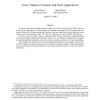341 search results - page 16 / 69 » Quantum Computation and Lattice Problems |
SIAMSC
2010
13 years 6 months ago
2010
A significant amount of the computational time in large Monte Carlo simulations of lattice field theory is spent inverting the discrete Dirac operator. Unfortunately, traditional...
ICCS
2003
Springer
14 years 26 days ago
2003
Springer
The exact enumeration of most interesting combinatorial problems has exponential computational complexity. The finite-lattice method reduces this complexity for most two-dimension...
ICS
2010
Tsinghua U.
13 years 11 months ago
2010
Tsinghua U.
Quantum k-SAT is the problem of deciding whether there is a n-qubit state which is perpendicular to a set of vectors, each of which lies in the Hilbert space of k qubits. Equivale...
GECCO
2008
Springer
13 years 8 months ago
2008
Springer
Quantum-inspired evolutionary algorithms (QIEAs), as a subset of evolutionary computation, are based on the principles of quantum computing such as quantum bits and quantum superp...
ECCC
2007
13 years 7 months ago
2007
We propose a general cryptographic primitive called lossy trapdoor functions (lossy TDFs), and use it to develop new approaches for constructing several important cryptographic to...

